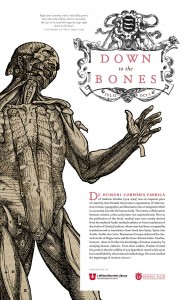Tags
Andreas Vesalius, Arabic, cadavers, Classical, De Humani Corporis Fabrica, Galen, Greek, Hippocrates, human anatomy, Latin, Luise Poulton, modern science, Renaissance Europe, Special Collections Gallery, Syriac, typography
Exhibition: Down to the Bones
Curator: Luise Poulton
Location: Special Collections Gallery, J. Willard Marriott Library, level 4
Gallery hours: Monday–Friday, 8:00–6:00; Saturday, 9:00–6:00; Hours differ during University breaks and holidays.
The exhibition is FREE and open to the public.
De Humani Corporis Fabrica of Andreas Vesalius (1514-1564) was an exquisite piece of creativity that blended observation; organization of information, format, typography; and illustration into an integrated whole to accurately describe the human body. The intense collaboration between scientist, artist, and printer was unprecedented. Prior to the publication of this book, medical texts were mostly derived from the medieval Arabic medical tradition or from translations of the works of Classical authors, whose texts had been corrupted by translation and re-translation: from Greek into Syriac, Syriac into Arabic, Arabic into Latin. Renaissance Europe embraced the classical works of Hippocrates and the Greco-Roman Galen. Vesalius, however, chose to further his knowledge of human anatomy by studying human cadavers. From these studies, Vesalius formed his position that the validity of any hypothesis rested solely upon facts established by observational methodology. His work marked the beginnings of modern science.



You must be logged in to post a comment.